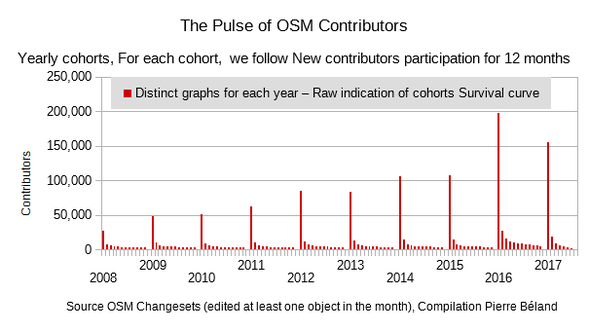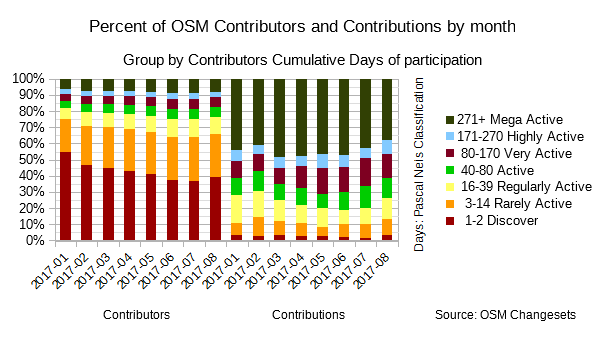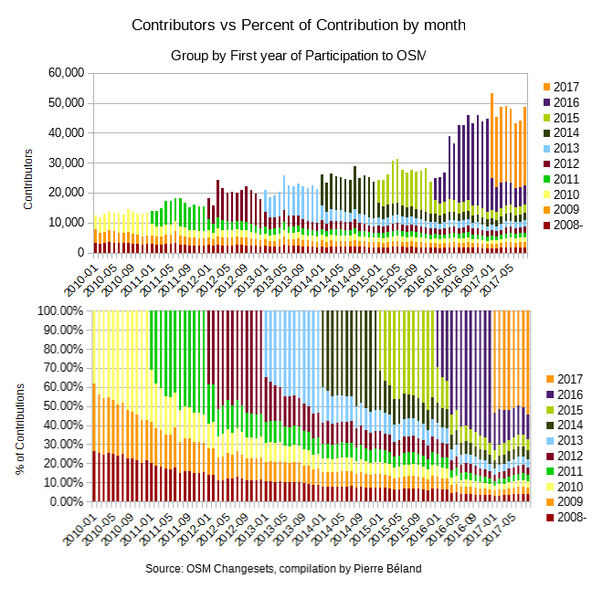The OSM Foundation started publication of the results of the The 2021 OSMF Community Survey where we can download a spreadsheet with the Comments received in the survey.
In the second section, you will find extracts of individual comments that I interpret as being related to the Question F1 about Diversity and Inclusion Special Committee and complaints about Systematic Offensive behavior in the OSM Community.
But first, if we look at all comments listed, my perception from the comments is that many participants to the survey are looking at the various actors and politics that are played and want to insist on various challenges facing OSM and often concern about the dynamic with the various actors and the various agendas. Note that this is anonymous data, and that comments below are my interpretation reading these.
The participants comment on the various actors and their actions, plus the impact on OSM. We can observe how they are seing political actions and the various actors and they perceive actions including from volunteers, Data Working Group (DWG), Influencers on Tagging discussion, paid and Corporate contributors, local communities and the usage of AI tools, Tagging of Disputed territories, Mechanical edits and Imports and even Non-OSM-Attribution by dominant Corporate actors. The OSM ecosystem creates great possibilities of collaboration and innovation for various products and answers to various needs.But with such dynamics, there are actors that are more in position of power like the Corporate actors, Software developpers or even small groups that control tagging schemes. Contributors like «tagkeepers» using mechanical edit tools have important capacity of action. Democratic play inside OSM means informations, discussions, and way to progress to concensus. But like any other political play, it is not easy to simply establish the facts, and accept to find solution, share powers with others, or accept that others have power they dont want to share.
While the various actors have their own priorities contributing to the map, Monitoring mapping and quality by territotries is a challenge. Various comments did ask for more attention to this and talked about the burden of monitoring for local communities.
Various responders to the survey perceived the implementation of the COC as political agenda often pushed by corporate actors. Below, you can make your own judgement going more specificcaly through to Diversity and Inclusion Comments.
The comments below are extracts from the 2021 OSMF Community Survey that I identified as being related to Diversity and Inclusion and CoC.
We dont know the context, and accusations are often not substantiated, not motivated. We are not sure if they are related to Coc problems, but they surely express tensions in an organization with so many actors, various problems to look at and various power dynamics with actors who do not all want to go in the same direction. The question, could these comments help us find solutions to address the various diversity problems expressed ?.
Diversity and Inclusion committee seemed like a knee-jerk “we want to be seen as doing something” reaction. I see a danger of the topic being occupied by people who want to increase their own power through championing diversity. I feel that a more robust and assertive response is needed. Not “Oh my god you’re right OSM is bad and needs to change.” but “Is OSM really bad? Let’s gather some facts.” Because any change you make will put some people off and you need to have a clear picture instead of blindly submitting to US American values.
Fair, considerate and polite behavior are very important to me. My impression is that the OSM community is quite friendly. However, I strongly reject a code of conduct or similar. There are enough bad examples of how activists not coming from the community have taken control of projects in this way, implemented their ideology and marginalized or driven away the original activists altogether. I will definitely not submit to such an ideological machination. My more than ten years of collaboration would be over.
Fully support the work on Diversity and Inclusion, infrastructure, and especially the iD developer. Best of luck to you all!
Given all the challenges in 2020 I feel as if the OSM community is becoming more diverse and beginning to work together. Many of the historical issues within OSM are being address and a strong emphasis and zero tolerance approach must be given to offensive behavior. It is quite sad and discouraging to see people within the community who have invested a large amount of personal time and energy act unprofessionally. As the community grows more diverse I feel this type of behavior will NOT BE tolerated. Of course there will be disagreements along the way, and this is healthy, but individuals blatantly being disrespectful should not be tolerated. I myself have been involved with individuals asking/demanding personal information I don’t feel comfortable disclosing. As we grow as a community these issues become more apparent and I feel OSMF did a good job in 2020 making progress on addressing them.
Great call on convening a diversity committee, the FLOSS world is still tragically behind on this.
I agree with OSMF funding development and maintenance of key mapping tools. Also agree with the board’s attitude towards diversity as a key area to work in within the OSM community.
I agree with the creation of the Committee for Inclusion and the working group but I do not support the anti-Frederick Ramm movement ( Call for action…)
I am very much in favour of an active OSMF board that moves on the issues identified here, especially the code of behaviour and infrastructure support.
I think OSMF still needs to adopt a code of conduct for all its forums, otherwise we’re still avoiding some of the key issues and problems that continue to make portions of the community toxic and to drive others away.
I believe many of these decisions made by the Board will be vital in growing the community and making OSM a better, safer and more inclusive community.
I do not think that the special inclusion and diversity commitee is really necessary. In my opinion, FOSS communities like Wikimedia, OSM and others, do tend to get too political and such boards and commitees do not really help the spread and development of these great technologies. Let’s keep politics and commons seperate, to keep the focus mainly on the development of open maps. We do need to keep the policits aside, if we do not want to let these communities become like the Chaos Computer Club, which is a mainly liberal/leftist hackerspace now, and not the nerdy, open to everybody organisation it once was in the 90s and 2000s.
I feel strongly about creating a safe, equal, healthy, and inclusive OSM, and completely agree with the Call to Take Action letter (I was too late to sign it, unfortunately).
Adding censoring is also something I am against. Of course, there are mean and stupid people in the (OSM) world. Will those people cease to exist if you censor the written word?
Do not try to bring in more women, gay or coloured people into OSM, or something similar. OSM is not about gender or colour. It is about a map. Focus on getting interested people to map (or use the map). If you try to include some specific attribute, in the same way you exclude all others. With the Diversity and Inclusion Special Committee you add politics to OSM, whither it was intended or not. Keep OSM about technology. Everyone can be included in that.
I have not witnessed any discrimination but diversity and inclusion are always good goals.
I hope that diversity criteria will be adopted for the selection of funded projects.
I hope the D&I committee looks into (and ultimately recommends to the Foundation board) the development of an OSM-wide Code of Conduct. This will allow all the diverse and co-operative OSM spaces to harmonise on what behaviour is encouraged and what is considered unacceptable.
I like that there is a discussion of diversity. I think the project would only benefit from such programs and initiatives.
I originally supported the action to combat “systemic offensive behavior in the OSM community” but withdrew my support after reading the concerns that it was somewhat questionable. I’m neutral because as a white male in the US, some would say I lack the perspective to make a fully informed decision.
I still think there is insufficient understanding of the reality on the ground of the conditions that local communities in Africa are facing. We are still a far too white, male, Eurocentric organisation and I hope that can change. I believe the board should be taking steps to accelerate that process, such as that there is representation from Africa and Women by reserving seats for them on the board.
I strongly support the diversity group and hope the board does more about a code of conduct
I think it was a good idea to create this committee regarding offensive behavior. The fact that someone actively colaborate on the OSM is not an excuse to mistreat other volunteers. The idea of a community is to help each other in this learning process which results will help to many regions of the world.
I urge the board to create mechanisms or processes for (1) monitoring the state of affairs related to systematic offensive behaviour as well as diversity, equity and inclusion in the OSM community and (2) addressing grievances related to systematic offensive behaviour in the OSM community.
I wasn’t following the board at all in 2020, but any decision to improve the technical/engineering capacity of the foundation is good. The diversity one not so much – having more diversity is a “first world problem”, OSMF isn’t so rich that it should give it too much thought. Better focus on improving the software and functionality of OSM.
I, personally, hate the creation of the Diversity and Inclusion Special Committee. It is my firm belief that there currently 0 discriminatory factors or policies against women or minorities. I also believe that Local Chapters should have a meaning to them. There isn’t much we as local organisations can do if we “sign on” with OSMF, except maybe having bragging rights.
If you have a diversity and inclusion committee, then there is no point in me using you instead of Google Maps, the latter being far more user-friendly.
If, by “inclusion” you mean to include people who are wantonly destructive of the work of others or who cause major upset to long-standing members - then NO I don’t want inclusion. Somewhere it must say that people who are antagonistic to the ethos of openstreetmap are NOT welcome in the team. There is a small step which must be resisted at all costs, between not rejecting people because of colour, faith etc, and demanding percentages in Openstreemap teams corresponding to general distribution of the poplulation. It is the death of meritocracy. Meritocracy first please.
I’m a bit torn on most of these decisions - or see at least a certain potential for negative consequences in the future.
I guess that one of the first results (apart from more, potentially heated, discussions ;)) of this might be a CoC - I’m not a huge fan of these, but I’m not really against them, either (there often are coding style guidelines in software projects and we have the wiki where we write down how we map, so why shouldn’t we write down how we want to interact with each other). But I do think that it’s really hard to come up with a good CoC for a really global project like OSM that can’t be abused to silence criticism or to spawn meta discussions that detract from the actual subject - I think it’s especially hard since there are people with so many different cultural backgrounds involved, who, at least on English channels, are often not even discussing in their native language, so there is a possibly huge potential for misunderstandings - which could be abused. That doesn’t mean we shouldn’t try to come up with a good CoC, but that we should be careful.
I’m excited to see OSM invest in fixing systemic issues starting with rooting out abusive behavior. The community and the project cannot grow unless the toxic dynamics that have been a long-time part of the community are forbidden.
I’m glad that work is being done to combat the misogynistic tone in the OSM community. I’m sure there are more work to be done in terms of inclusivity and participation of marginalized groups, but this is a good start that gives me hope.
- It would be good to use non-sexist language In OSM communications, such as this one! Only volunteers? Or volunteers? It goes against including women and diversities In the OSM community. I personally felt assaulted by the community and this does not help.
I ranked the decision for the Diversity Committee as neutral because I think in principle it was a good idea but there is not much outcome yet and it is not clear for me if the committee still exists.
It seems obvious to me that our community is very (too) masculine, however I find it difficult to see what the barriers to women’s participation in the project are. I make the assumption that they are generally less interested in mapping. Having participated in several SotMFr, I have met quite a few women, and they seemed to have their full place in the project, including in leadership. I did not see any sexist or exclusive actions against them. Maybe some problematic situations are taking place in other parts of the world?
I consider that in its concept, OSM is open to everyone, all you need is an email address and a map? Most of the time we don’t know who is hiding” behind an identifier, so I think we are all on an equal footing. In my opinion, the question of gender is a very “North American” concern and I fear that these debates will spoil our project. I would suggest that we should rather ask ourselves the question of access to OpenStreetMap according to social classes or income levels. Let’s work to make the community more open to ““non-Western””””.
Keep politics out of open-source projects. Introducing identity politics only alienates community members and does not foster unity, regardless of the intentions of people introducing the concept. In fact, such measures usually have a back-firing result and appear to appease solely those functioning within the US/Western European cultural realm, while negatively impacting others.
Kudos for starting a Diversity and Inclusion committee! I really hope the committee quickly and effectively puts in place a Code of Conduct policy, and the OSMF provides enforcement support for it. I am aware of OSM mappers who have quit OSM mapping due to the rude and hostile efforts of single individuals.
Maybe there are systemic problems in the OSM community, but if there are, that email thread linked in decision wasn’t an example of it. I think that the reaction to Fredrick’s email was a lot more problematic than his message, and if the Diversity and Inclusion Special Committee will try to promote this behavior then I’m firmly opposed to its current form. That said, I’m all for the committee trying to promote diversity without going after normal members of the OSM community.
More quality, more usability, less autocratic rulers among authors.
Much of the measures to fight “offensive” behavior is a power play to favor some groups over others.
Personally I haven’t encountered any negative issues with behaviour on OSM. I work in the Geospatial Community and I value the inputs of my female colleagues, just as equally as my male colleagues. (Disclosure - I am Male)
My response to question one is based entirely on what is written in the question. Codes of conduct and diversity and inclusion committees sound great, but can be implemented very poorly, in some cases completely failing to support the minorities which they should be supporting. I don’t mean to say that the OSM implementation of such a committee is like that — I am not involved at all closely and have no idea. I hope it’s a great implementation. But I don’t wish my response to question one to be interpreted as support for anything other than the concept in general.
Paying for iD maintenance would be less OSM-incompatible if the developer had been a volunteer. Someone who joined the project for the sake of the project. Factually, however, it turns out that the developer was already initially hired as a full-time employee, never cared much for Do-Ocracy and/or the community, and (even if not explicitly communicated) was actually blackmailing the community: “Pay me or I’m gone”. All a very bad sign for our community. The handling by the board was ok, the implementation/result mMn not.
The handling around “inclusion and diversity” was and is unacceptable. We have been creating an increasingly hostile environment in OSM for years that suppresses the open exchange of opinions and discourse in favor of a very loud and aggressive minority. “Inclusion and diversity” is an important and good goal. However, one must be allowed to ask and discuss what diversity is important. For example, it often seems to be much more important to have a quota of women instead of geographic diversity. The fact that the board e.g. directly supports the pro-CoC people but obviously does not condemn the open toxicity” towards Frederik Ramm with a single word is only one of several examples that is unacceptable for a board that stands for a cosmopolitan broad community. We seem to prefer a US-American worldview of a broad, open harmonious community, unfortunately.”
Please continue cleaning up poor conduct and make this an inclusive community. We must take this seriously and create a safe space for all folks to contribute and be heard.
Please, don’t be pressured to spend resources on Leftist propaganda like “systemic” (viz. Top-down organizational) bad behavior toward dark colored folks. In fact, it seems, if there is any systemic hatred today, it’s towards lighter colored folks! If not, it is true that “all have sinned,” so let’s remove all inequality (note: I did not say “inequity”) toward anyone; let’s just treat everyone with equal judgment, fairness, and opportunity.
Special Commission for Diversity and Inclusion is needed in my opinion. The issue is completely overrated. With respect and common sense, none of this is necessary.
strong upvote for all work done in support of code of conducts and otherwise being transparent about creating safe spaces for everyone in the OSM community
Thank you for the attention to harassment versus inclusion. More needs to be done. As we can see strong leadership is critical. The women and BIPOC mappers are the future of OSM.
The ““Diversity” and Inclusion Special Committee” comes across as incredibly toxic, racist, and misandric. The language their use is extremely off-putting.
The “open letter” mentioned in the first point has taken a hostile tone towards a great number of OSM contributors and in my opinion that’s disqualifying for a document that is supposed to promote friendly development of OSM. No significant board action should be taken on the basis of heated and aggressive argument.
The decision to combat offensive behavior in the OSM Community by promoting Diversity and Inclusion is in my opinion wrong. Diversity and Inclusion will continue to recognise and act on the differences of contributors, (human beings). To call yourself any name, race, creed, colour, gender or religion is to be violent. Because you are separating yourself from the rest of mankind. When you separate yourself by any means, it breeds violence.
Can we please instead call for ABSOLUTE EQUALITY.
The Diversity and Inclusion stuff is a slow and lethal cancer for any open source project. Eject these grievance activists from the project before they destroy everything.
The diversity thing is tricky. To me it feels like virtue signalling, I don’t think it makes a systemic difference. On the other hand it’s probably better to have it than not to have it as it does force some conversations, at least. I don’t know what will make a systemic change. For me personally I don’t have an interest in serving on the board to push the change for more inclusivity, because I think the issues are too deep. I think it’s better to start a new thing, but then I feel like that re-invents the wheel.
The first question is poorly designed IMO. I agree that systematic oppression is awful, but this isn’t an OSM issue. We should be focusing on that all locations/countries get a say, it doesn’t matter what race,gender,age e.t.c. you are.
The first question on diversity and complaints about offensive behavior is hard to judge, as the link didn’t supply any background. I have no way to know if this was an over reaction or an under reaction! So I just selected “3”.
The lack of a clear Code of Conduct and an enforcement mechanism will haunt OSM and continue to make it not a safe or welcoming environment.
The Special Committee on Diversity and Inclusion is counterproductive and should be abolished again.
The way the discussion in the thread “Call to Take Action and Confront Systemic Offensive Behavior in the OSM Community” went was shameful. To me it seemed like a possible OSMF candidate took the opportunity of a personal attack on Frederic to not only avoid responding to a very legitimate question, but also to engage in the personal attack himself to avoid the question.
I support the action against abusive behavior. This is unfortunately far too common in OSM.
There is little guarantee that the Special Committee on Diversity and Inclusion will not become a censoring body in favor of some communities in favor of others. It seems to arise from the victimhood of some and the desire for censorship of others.
To question one:
The Special Committee itself serves only to spread racial and gender hatred. As you can read in the links.
There the picture is drawn of the white and male oppressor who is to blame for everything.
The eternal white man…
We MUST ensure the continued independence of OSM and ensure there is no undue influence from other organisations, particularly very large companies with financial muscle and a desire to influence its direction at the expense of the views of the huge number of contributors (past and hopefully future).
We need more action and investment regarding diversity and inclusion. This should be first priority.
We need to do something to get more people into OSMF who are not Germans, we have a very bad disbalance.
Well done Board! I appreciate you innovating and steering OSM towards greater sustainability and inclusion.
When possible the board should take a more active role in the diversity and inclusion work.
While I (partly) agree with the sentiments outlined in “A Call to Take Action and Confront Systemic Offensive Behaviour in the OSM Community” I woudl suggest that to characterize these as “Power dynamics in OSM are controlled by a dominant contributor profile: white, Western and male. This power dynamic has led to a communication style which includes misogynistic, hostile, targeting, doxing, unfriendly, competitive, intimidating, patronising messaging, which is offensive to us and forces many of us to remain as observers and without the confidence to participate actively.” Is in and of itself discriminatory (I have been a ‘victim’ of this kind of attitude, and I myself am white-higher educated and so on.) What in my opinion is at issue here -and in other cases within the Open Source community- is that quite a few contributors themselves have issues (i.e. Asperger/Autistic spectrum would be a dominant trait I imagine) which may mean these people themselves are/feel unsafe in the “real” world and have ‘created’ a safe space for themselves and do not like/want what they perceive as intrusion in ‘their’ world. So only focusing on he perceived victims would leave out people who themselves may be victims too.
About 1st question of diversity group. I see some FUD there. Moderation and conflict resolution mechanism between people is replaced by bureaucratic norm, which development is passed back again to community. I agree that something should be done (to reduce people distress), but I disagree that such approach really works.
Adopt
- Non-violent communications - as a best practice ( as a root problem of diversity )
“Diversity Training’ Doesn’t Work. This Might.”
https://heterodoxacademy.org/blog/diversity-training-doesnt-work-this-might/
Adopt a corporate member admission policy, which bans members (both current and aspiring) that are widely known (with published evidence) to have had problems regarding compliance with law, human rights and protection of the environment.
Be more in touch with the diverse and inclusive communities of OSM, and take actions for their participation and strengthening.
Diversity and Inclusion seems to be only talked about a lot in emails. The board should encourage those to champion it through actions not only good public relations that does virtually no good.
Diversity and providing a safe space should be the top priority, but it was not in theboptions.
Diversity of the OSMF: Global representation
- Impact of the fee waiver policy: Is the board receiving a more representative voice from the community, are grantees contributing to working groups and committees, what’s the ease of joining a working group? Any barriers?
Do not bring “political” problems to project where only (basic) barriers of entry is: device (desktop, laptop, tablet, smartphone) and decent internet connection.
Establish a climate of trust and caring (starting with its members towards any member of the community, no matter how aggressive they are). Change its mode of governance in this sense. Do not forget that the more sincere you are and the more you say what you do, openly and not in secret, the more you gain the trust of the community.
Explicitly improving communications, and working on the code of conduct implementation, should be a prime goal of the OSMF
Fix the toxic accusation of US based organisations (OSM US, HOT) that OSM discussion channels are unsafe for participation. They are not.
Guard against social justice activists the same way you would guard against a third-party takeover, or they will eventually cripple openstreetmap.
i am pleased to see the OSMF board of directors taking issues of inclusion and diversity seriously, as these have long-impacted my experiences within osm
I believe a code of conduct is absolutely necessary to create a vibrant and successful OSM community. Some members are extremely territorial of certain data, and that can discourage well-meaning individuals from contributing.
I guess I already commented on why I think a CoC would be good. Perhaps planning around OHM?
I have the impression that the topic of (neo-)colonialism is discussed surprisingly little for a community around free cartography. In the end, it seems to be mainly the chapters from areas oppressed by it that deal with the topic. This is a problem, because especially with MapRoulette and the like, it is important that mappers from former colonial powers develop an awareness of how cartography is related to power. I hope that this conversation can also be part of the diversity effort.
I indicated that I think the inclusion of local communities is very important. However, I would like to add to this that I myself avoid the German-speaking community because, as a queer person affected by sexism, I feel put off by some of what I see of it publicly - such as the German version of weeklyosm. While that’s not the board’s responsibility, I think it’s an important aspect of the question of inclusion, and I hope that any positive changes to the board will also encourage local communities to address their exclusions, which have been less likely to do so.
I stopped following many talk lists as I was tired of the increasingly aggressive, negative and toxic rhetoric being spread about. A code of conduct is needed on a project of this size.
I think the perpetual malaise in the OSM community (aggressively reactionary attitudes from old-timers, toxic language on the mailing list, extreme distrust of outsiders such as Facebook or Apple, a wiki that is denounced as not prescriptive but also clearly used as such) much of this stems from the absence of leadership in OSM. Unlike many other open-source communities, this “do-ocracy” is rudderless, and I think a lot of members who have devoted themselves to the map for years feel anxious not knowing where this flock is headed next, and react aggressively to protect what they love.
Leadership does not have to be about giving orders or imposing rules, but it can serve to channel decisions and coordinate the community’s actions. I would not mind seeing the Board take a more active role in leading the community. I find it encouraging that this survey includes questions about AI-assisted mapping and vector tiles, for instance.
I would encourage the board to set a tone that OpenStreetMap should be an open, inclusive, collaborative, and friendly environment for mapping enthusiasts to collectively build a great map of the world. It is a wonderful project with enormous potential but unfortunately is often not a welcoming environment (e.g. talk lists), which I believe tends to discourage participation and collaboration. As a community, I’d love to see us set a great example of how a wide variety of people can work together online and in person to creatively and respectfully to build something wonderful. Let’s resolve to be better in 2021 and beyond.
Identify marginalized and under represented communities and merging Community NGO and give them approval as local chapters .Provide direct support to encourage new local communities of OSM even when they are not approved local chapters
I’m very concerned about the quality of data coming out of this survey. As someone who cares about OSM but rarely contributes due to toxicity, most of this survey was really opaque. Having to spend hours reading a documentation to even understand the questions felt exclusionary, and strongly demotivating. Some of the documentation didn’t even provide any further explanation on the items it was supposed to inform (like several items on the list of things to prioritise). Only one question had a “no opinion” choice, so people completing the survey will answer at least some of the questions at random. Having to sign up with an email probably also lost you a lot of answers from under-represented community members. That said I’m happy this survey at least made me aware there was a D&I effort started.
Improving communication channels - listening to the few same men arguing pedantically drives people off the mailing list, and away from participating in the commuity.
In cases of sovereignty disputes, OSM by default displays the labels of the major powers. For example: the Falkland Islands are Argentinean, there is a dispute recognized by the UN, but OSM shows the British name tag. Please train in this kind of geopolitical conflicts. Above all: do not take sides in a globally unresolved and openly disputed case.
- train in feminist mapping and gender and diversity issues.
- it would be good to use non-sexist language in OSM communications, such as this one! Only volunteers? Or volunteers? It goes against including women and diversity in the OSM community. I personally felt assaulted by the community and this doesn’t help.
it is difficult to have an opinion on the ai/ml question without understanding what osmf and the community sees as a future for the volunteers. …
i have not engaged on that topic, btw, because there’s no CoC. it is beyond time.
It is important and right that in the OSM community as far as possible no one is subjected to disparagement, insults, intolerance or discrimination.
However, to avoid backfiring, it is equally important that the rules and tools created to achieve this goal, if any, are not abused to push certain opinions and (falsely) brand all other opinions as “intolerant”, or to suppress factual criticism or critical discourse. Therefore, it is essential that
- the rules and tools are applied with moderation
- there are proper procedures and appeal possibilities
- the evaluation of incidents is done by uninvolved independent third parties (e.g. an ombudsperson)
- it is clear to all community members that not everything that disturbs, criticizes or puts you on the spot” (or even disparages you) is acceptable. (or even belittled, insulted, discriminated against or not tolerated) is necessarily belittling, insulting, intolerant or discriminatory”
Loosen the control and opinions of the German community on OSM as a whole. Their strong voice may cause others outside of Europe to not participate in OSM as openly. They tend to be the vocal 1% in the community and I don’t think it is helpful on a global level.
Maintain and secure the spirit of OSM as a free and participatory geodata platform. And in doing so, counter commercial interests and the influence of large companies. And in doing so, promote and, where appropriate, moderate exchange within the community. It must remain a global project supported by many voluntary mappers, and must not degenerate into a “data supplier”.
Mapping for illiterate users is an important problem in the underdeveloped world. It is a task that requires attention by the open source community.
More inclusion of mappers and enthusiasts from the developing world
More stable and performant core infrastructure
Allowing local communities to define country leves tags to be loaded by default on ID editor
More representation from the local community group, as this survey itself how it is challenging to get diverse participation from the OSM community outside Europe and North America.
More sensitization of the local communities.
Multilingualism must be supported because it is the basis of multiculturalism. It seems important to me that the Board of Directors validate the fact that, being a global project, there cannot be only one language, official. English is the most common language for exchanges, but it should not be exclusive.
Multilingualism must be supported because it is the basis of multiculturalism. It seems important to me that the Board of Directors validate the fact that, being a global project, there cannot be only one language, official. English is the most common language for exchanges, but it should not be exclusive.
One of the strenghts of the OSM community is it regional scope with local chapters. Please do more to support them. Using the funding available to let them achieve projects in their home country
OSM is VERY important in a world that needs mapping on a local level throughout the world. I would love to see more activity on the local level and I will seek out local people to help keeping OSM viable and useful.
OSM membership and leadership should evolve to look like the world it is situated in if it is truly the people’s map. More inclusion and proactive welcoming of women and people of color (and protecting them from rampant harassment) is not only the right thing to do : it is critical for the future of The Peoples Map - OpenStreetMap.
OSM must be and REMAIN independent from political and commercial actors !
OSM must be politically neutral !
Minorities should be represented at OSM.
However, diversity must not lead to discrimination against “Old White Men”.
OSM should not be used to propagate ideas about how society should be (except about open data).
OSMF is years over-due to adopt a code of conduct for public forums, conferences, and so on. The majority of participants either feel strongly that this is a positive move or, frankly, don’t care that much. It’s an outspoken subset that continue to object to this. Either OSMF will solve this issue and adopt a CoC, or the OSM community will fracture at some point.
The low number of women involved in OSM is a bit of a canary in the coal mine. Boards and projects that have few or no non-men involved should work actively to recruit a wider range of participants and should also discuss why that may be the case. I mean this in a positive way. Having more folks involved in this effort will benefit everyone and the overall OSM effort.
Pay attention to more discipline in the forum. Sometimes things that affect only a few points in the database are discussed to death.
Please implement a code of conduct and increase outreach outside of OSM to bring in new mappers, governments, &c. Also I think attribution guidelines are fine how they are
Please look into corporate user guidelines more critically. Local communities in few geographies are trying to bully corporates even if they are adding information with good intentions.
please take action against long time bad actors in the community
Prioritize communities rather than expertise. CODE OF CONDUCT. Be welcoming and inclusive. Stop protecting the organic rock stars just because they are seen as “important” people in OSM. They are the ones being unwelcoming and a threat to local communities.
Put in extra work around the issue of inclusivity. A community made up of predominantly white men will not change if no effort is made. Even if the community feels there is no animosity towards others, the current dominant demographic is a self-entertaining and self-reinforcing characteristic. This community needs actively give more of a voice to women, gender-diverse, and POC contributors. Otherwise, nothing will change.
Remember that the loudest voices are not necessarily the ones that contribute the most to the project
Repeating from page one of this survey:
One of the points of the https://wiki.osmfoundation.org/wiki/Etiquette is “Don’t publicly call people out.” The “Call to action” that launched the recent OSMF mailing list debate broke that point by publicly calling Fxxxxx out. I respectfully request that the author and all signatories of the document up to the point when Frederik’s name was removed from the document are considered to have breached the OSM Community Etiquette. Since at least some of them are members of DISC and LCCWG, these bodies would be biased in considering this request, so care should be taken to ensure impartiality. I’m not sure what the consequences of breaching the Etiquette are, but I believe we should have this conversation.
Talking about the wiki: Sometimes, there are people, that are set to change something to better match their own thinking and getting that due to sheer stubbornness, no matter how their arguments are proven insufficient or how many other people disagree, it is frustrating that there is no formal dispute resolution process
The board needs to undertake a study to address the racism and misogyny within the OpenStreetMap community. Quantifying the harassment and intimidation of non-white mappers needs to be studied and reported back to the community to validate the extent to which it exists and ensure this behaviour is not tolerated.
The board should affirm the diversity of the community, including in terms of its corporate members. The board should affirm the diversity of mapping, including with machine edits and bulk imports. OSM is a valuable and unique global resource, and should marshal all possible resources to continue to make it open, relevant, and accurate. This includes corporate, nonprofit, and hobbyist uses.
The board should do everything to ensure that the OSM community is NOT dominated by commercial institutions!
The diversity issue can be frustrating to read all the time, coming from people who dont have solutions other than abstract top-down policies. OSM needs the input of different people, but just gender proofing alone is superficial. The actual solution is a recruitment strategy that gradually allows different kinds of skills, focusses, professions, regions, genders into the community as influencers.
The Etiquette Policy does not work. The “assume good faith” clause is often cited by those who act with disregard (conscious or unconscious) towards others in order to silence criticism or concern from underrepresented community members, but they never assume the good faith of anyone else when making criticisms of others, with no consequences for them, while serving to drive away the majority of community members. This appears especially to be the case for “prominent” community members who map regularly and/or are heavily involved in software projects, seemingly because they are “too important” for the community to censure or reject.
In a similar vein, one of these mappers (Mxxxxxxx) publicly and blatantly violated the Code of Conduct at State of the Map multiple times with zero consequences. Instead of being removed from the session or the event, he was merely given a verbal warning, which he ignored.
I remind the Board of the lesson that many other organizations have learned: Being dependent on jerks does not say anything special about the jerks’ abilities or dedication, the jerks just drove away everyone else that was willing and able.
The board should cease indulging the increasingly paranoid fantasies related to “takeover”. We are all bound by the license. The greatest threat to OSM–and sadly, the likeliest scenario for its future–is its capture by an incredibly small faction of extreme voices. This is a project used by billions and governed by, what, 700 voters? Who mostly interact in mailing lists that are universally understood to be full of toxic flame wars and bikeshedding? This is not a perilous dynamic. The needs of the multitudes who depend on OSM must be given dramatically more weight as the project charts its future course.
The messages exchanged in the OSMF mailing lists are more and more offensive and dominated by few people. It’s time to take strong decisions against those people (including perpetual removal from mailing lists) even when there is only one single episode. This is limiting many people from participating to the OSM discussions. I have personally lost trust and I am currently almost not following the discussions anymore for this reason.
The opportunities for participation are to be propagated further. However, this requires further work on conflict resolution mechanisms.
The OSM board has to prevent that one or more commercial companies together take over the community in a hostile way to reshape OSM according to their commercial interests.
The OSMF should encourage a healthy discussion between corporate members and the OSM community so we can reach an agreement on an Attribution guideline that works for everyone.
The osmf-talk list should not be the main channel for communications. OSMF should switch to a more modern platform, and think carefully about how to encourage constructive and supportive dialogue. Note the OSMF listserv can stay and those who dominate it can stay there.
Urgently take steps to increase ethnic and gender diversity on the OSM board!
Watch out for big company attempts to influence OSM.
We need greater dissemination of decisions and governance system.
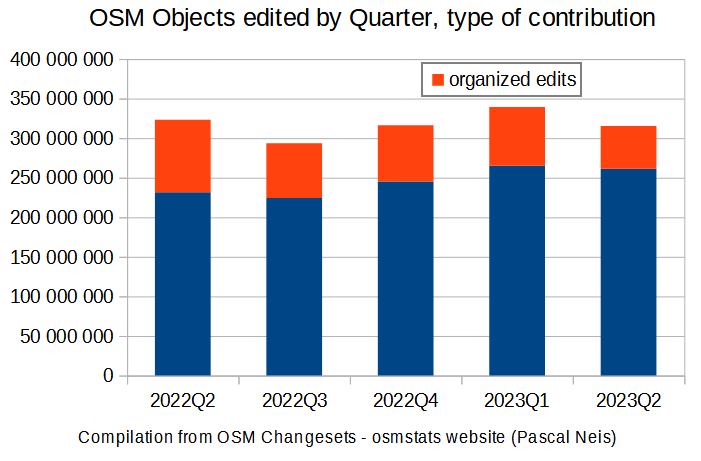
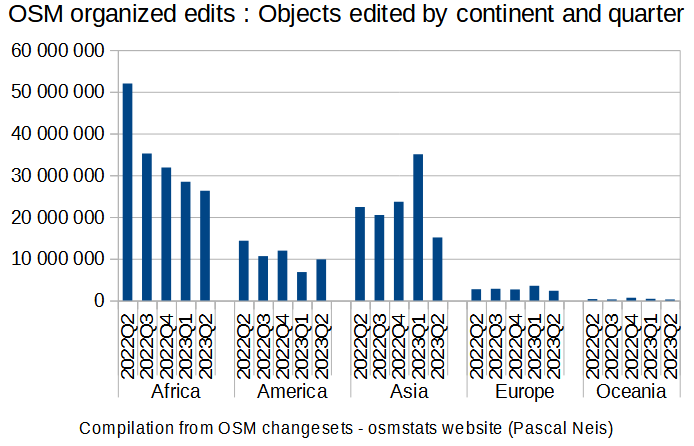
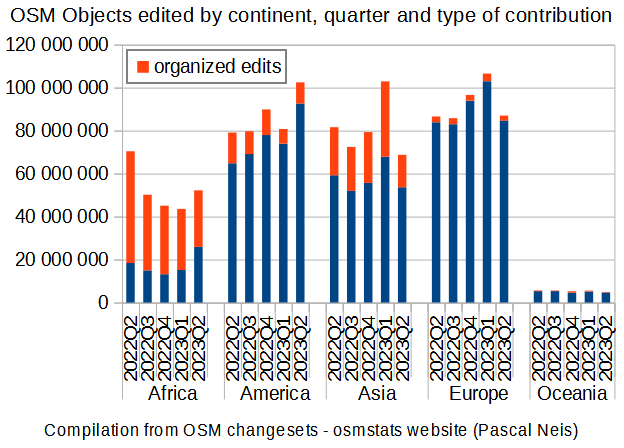



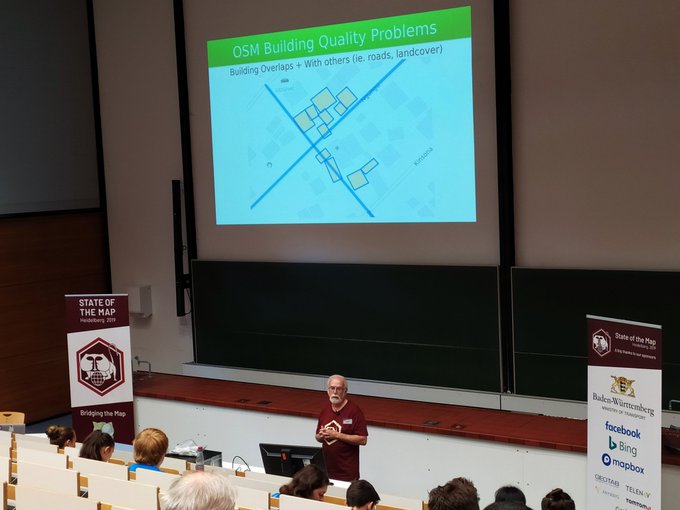
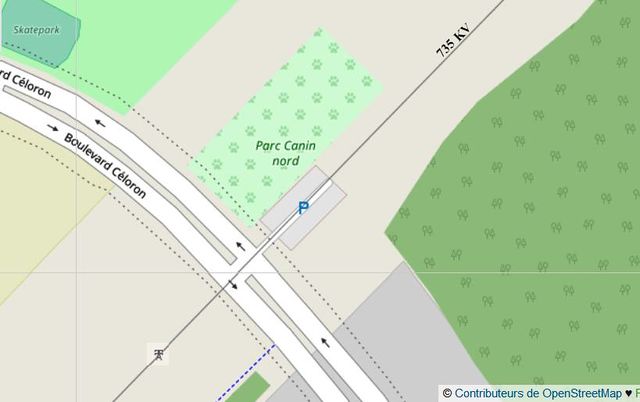
 Talking of the OSM Contributors, we often see the Big Numbers. In this Diary, my objective is to focus on the OSM Contributor profiles, to try to measure the impact of various groups on the OSM Edit Contributions.
Talking of the OSM Contributors, we often see the Big Numbers. In this Diary, my objective is to focus on the OSM Contributor profiles, to try to measure the impact of various groups on the OSM Edit Contributions.